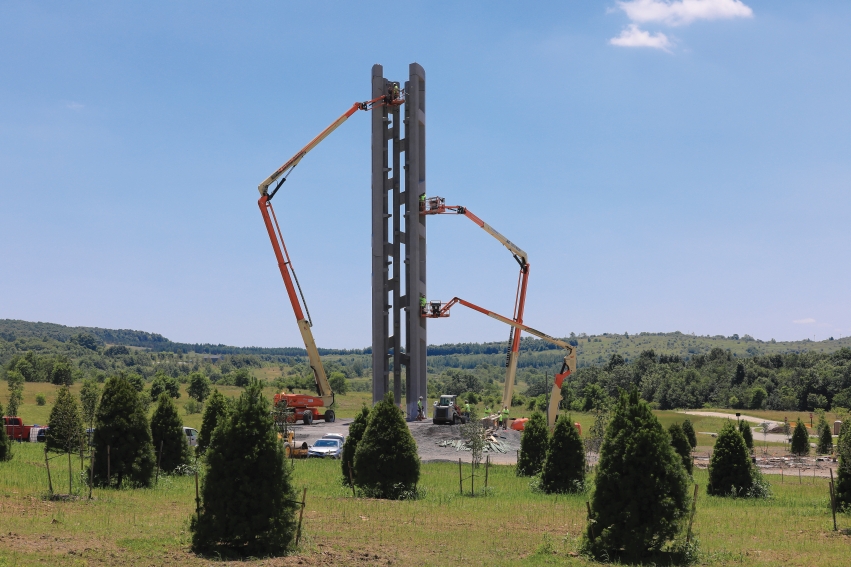The Tower of Voices will provide a living memorial in sound to remember 40 citizen heroes who lost their lives on September 11, 2001.
This September, a monumental wind chime structure will be dedicated near the entrance of the Flight 93 National Memorial Plaza in Somerset County, Pennsylvania. Built to honor the 33 passengers and seven crew members who died thwarting an attack on the U.S. Capitol, the Tower of Voices will represent each life lost through a set of 40 tones playing in the wind. The completion of the 93-foot tower marks the final phase of work at the 2,200-acre national park, located at the crash site of United Airlines Flight 93.
Fugate Inc., a musical instrument manufacturer and distributor based in Morton, Illinois, is constructing the polished aluminum chimes for the tower, having submitted the winning bid to the National Park Service in late 2017. Featuring eight-inch diameter chimes ranging from five to 10 feet in length, the tower’s colossal scale is unlike any other chime structure in the world.
If You Can Dream It…
Architect Paul Murdoch designed the award-winning Flight 93 National Memorial Plaza, which opened to the public in 2011 on the tenth anniversary of the 9/11 terrorist attacks. His firm’s blueprint, selected among 1,099 entries from 27 countries, features a solemn design that earned the international WAN Concrete in Architecture Award in 2017 for its simplistic nature that speaks grandiose volumes. The Tower of Voices is the final piece of his overall memorial design, an idea he first conceived a dozen years ago.
In a video posted by photojournalist Stephanie Strasburg, Murdoch explains his inspiration: “This tower… would be monumental in its stature but intimate in its experience. Because the last contact with many of the passengers and crew members on the flight was through their voices, we wanted to create a memorial in sound and in dialogue with this site as the rest of the memorial does. So we conceived of 40 chimes in the tower that would speak through the wind, always changing with the natural forces of this place.”

The Tower of Voices is conceived as a monumental, 93-feet-tall musical instrument holding 40 wind chimes, representing each of the passengers and crew members on Flight 93. The intent is to connote serenity and nobility while also recalling the tragic event that consecrated the site. Rendering courtesy of Paul Murdoch Architects
Sam Pellman—a renowned music theory scholar and former professor of music at Hamilton College in Clinton, New York—created the pitch design for the tower’s chimes. In an eerie twist of fate, he died tragically last year, shortly after completing the arrangement—a final ambient composition defined by a hauntingly harmonious dissonance. The Tower of Voices will be his legacy as well.
Pellman’s work relies on just intonation—a unique musical tuning in which the intervals of notes are related by ratios of whole numbers corresponding to the harmonic series, a vibrational pattern found in physical objects which correlates to human perception. Just intonation is a tough concept. It’s not a particular scale or musical style, but rather a set of principles.
In short, Pellman based the music on fundamental elements of melody and harmony—a mathematical system that allows each individual chime to produce a distinct sound, while playing nicely with the other 39 chimes. For the Tower of Voices, he’s created an infinite combination of tones to be heard as voices on the wind—producing a pleasant ring, yet hanging tense in the air like a final plea.
Sculpture of Sound
 Achieving this grand objective via five- to 10-foot-long metal tubes is not an easy bill. Fortunately Brett Fugate, CEO and founder of Fugate Inc., was perfectly suited for the challenge. Both a longtime musician who specializes in tuning and a molecular biologist by training, his own incongruous background makes him uniquely qualified for a project that is both art and science.
Achieving this grand objective via five- to 10-foot-long metal tubes is not an easy bill. Fortunately Brett Fugate, CEO and founder of Fugate Inc., was perfectly suited for the challenge. Both a longtime musician who specializes in tuning and a molecular biologist by training, his own incongruous background makes him uniquely qualified for a project that is both art and science.
“I initially contacted [the National Park Service] when I heard about the project, with a simple inquiry. Then I sent them a compatibilities statement,” Fugate says. “I think my background in tuning and music and manufacturing was really a selling point for our company to be chosen. It was a good fit.”
The Tower of Voices is the company’s biggest project to date, though Fugate speculates that if he were to line up all the musical instruments they’ve made over the years, they might stack just as high. “We have experience building chime tubes. This is the biggest I’ve ever built,” he says with a chuckle, “but it’s not the first.”
Starting out as a percussion manufacturer, Fugate Inc. focused on drums, xylophones and marimbas before getting into wind and brass. Today, their Morton location carries a full line of instruments, used by professional musicians around the world. But that’s only the start, declares Fugate, whose company’s mission is to “continue to perfect the sculpture of sound.” In a means to reach that end, he insists his graduate degree in molecular biology is an asset.
“Having a background in science helps with the analytical processes in developing new instruments and tools. It’s also a long-term goal of my company to invent a new kind of wood that would be used on xylophones, drums and marimbas,” he adds, sharing his concept for combining multiple species of wood for a more sustainable instrument-building material. The Tower of Voices contract gets him closer to this goal, he explains, adding a few more employees while expanding the company’s breadth of knowledge.

Three cranes lift construction workers around the Tower as it nears completion in late summer 2018. Surrounding concentric rings of white pines and deciduous plantings may be interpreted as resonating “sound waves,” alluding to the chimes housed within. Photo courtesy of National Park Service
Catching Sail
In constructing this mammoth musical instrument, Fugate is, for the most part, following a blueprint. “It’s not a point of me wanting it to sound a certain way, as much as I’m following directions,” he notes. “I have a certain amount of artistic freedom, but I was given a scale.” Because he earned the contract after Sam Pellman passed away, he was never able to speak to the composer directly. “But the engineers I’m working with are very adamant about his scale and staying true to it.”
According to the National Park Service, the tower’s shape and orientation are designed to optimize airflow through its walls to reach the chimes in the interior chamber. The tower cross-section is a “C” shape, allowing sound to reflect outwardly from the open side in a fan-shaped pattern, with the chimes suspended 12 or more feet above the main plaza.
To build these enormous pipes, Fugate Inc. expanded operations from its Morton storefront into a few local warehouses for production. But Fugate suggests the project is relatively simple. “When you cut a tube—any kind of vibrating body—the shorter you make that tube, the sharper it becomes and the longer [it is], the flatter.” The size of each chime is dependent on the musical note and associated frequency it’s intended to produce. The real challenge, he adds, is the outside variables.
The chimes will be wind-activated, with internal strikers attached to sails projecting from the bottom of each. “When the wind catches that sail, it pushes or displaces and strikes the tube,” Fugate explains. “When the wind lets up, there’s another displacement of energy, so it can go back and forth.”
The project’s scale and complexity, coupled with the variability of wind directions and velocities, required a unique process of testing—including computational fluid dynamic modeling, wind tunnel testing and acoustic simulation to assess all possible chime configurations. In an effort to test his work on a smaller scale, Fugate even constructed a tower on-site in Morton. “As a scientist, you’re trying to control variables,” he explains. “But the wind is very difficult to control.”
The National Park Service developed a standard decibel range for the site—but the wind tends to pick up more sound downwind, Fugate explains. Reaching the intended target is of utmost importance, as the memorial strives first and foremost to be a place for quiet reflection and expressions of respect. The chimes must reinforce that objective—not too loud, not too soft; not too melodious, not too cacophonous; something in between.
A Living Memorial
As the 17th anniversary of the 9/11 attacks approaches, Fugate is hard at work finishing up the chime tubes and working on the logistics of transporting them to Pennsylvania. Fugate Inc. will participate in their installation prior to the dedication ceremony, hosted by the National Park Service, on September 9, 2018.
The completion of the Tower of Voices marks the conclusion of Paul Murdoch’s vison for the Flight 93 National Memorial Plaza, transforming the crash site into a place of symbolic healing. And how better to do that, than with what may well be the largest musical instrument ever constructed by man? It’s a fitting tribute, the architect declares. “The actions of those 40 were unprecedented. We will build here a monument the world has never seen.” a&s
For more information…
- Watch the construction of the Tower of Voices project via a live webcam at flight93friends.org/plan-your-visit/webcams.
- Listen to a simulation of the Tower of Voices wind chimes at soundcloud.com/smithsonianmag/tower-of-voices-wind-chimes-simulation.
- Learn more about Fugate Inc.—and its wide selection of musical instruments and accessories—at fugatedrums.com, or find them on Facebook.


